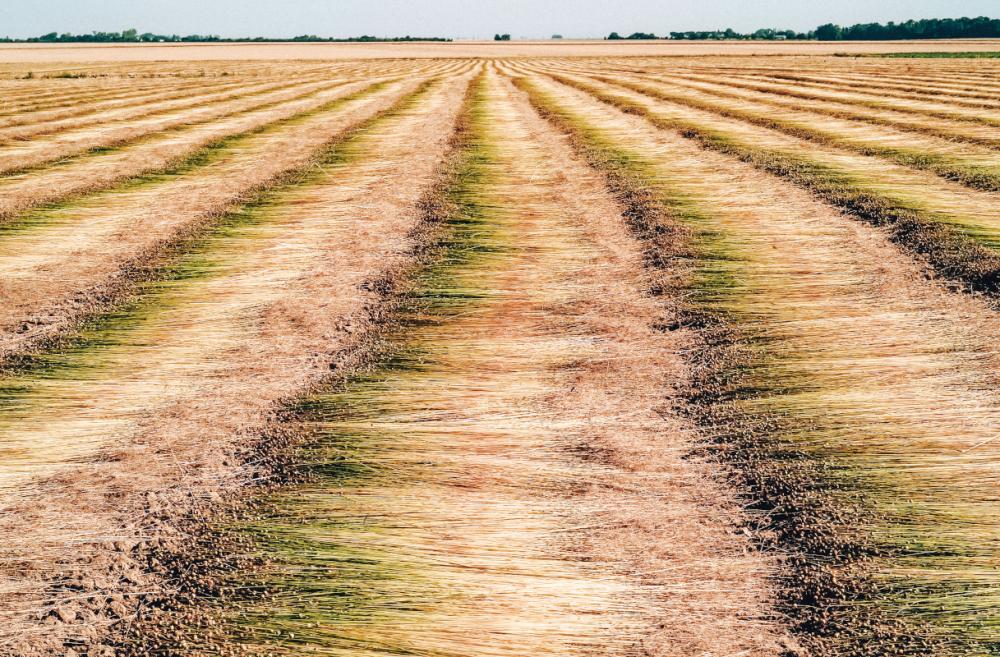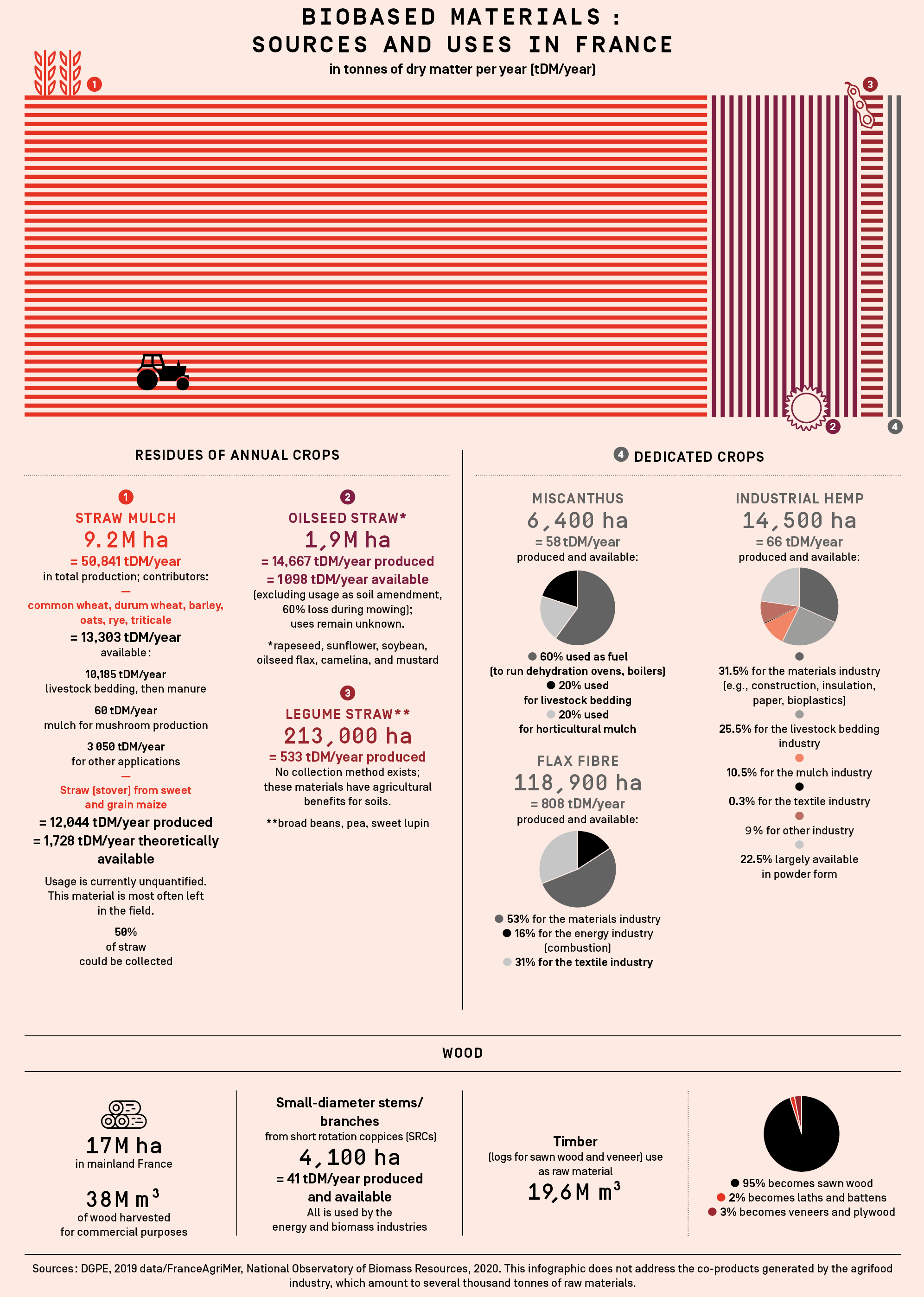Ressources dossier
BioeconomyAre 100% biobased systems realistic?
Published on 17 February 2023
There are myriad possible replacements for fossil fuels: dedicated crops, crop residues, forest residues, and miscellaneous sources of plant biomass. However, many such resources are already being used in well-established industries. For example, straw serves as livestock bedding in Europe in general and as fuel in Northern Europe specifically. There are also new industries that utilise wood residues to generate cosmetic compounds or plant residues to produce biogas via anaerobic digestion. No single agroresource will be able to meet demands for plant biomass. We must therefore combine various regional resources without creating competition with food crops.
Monique Axelos, Scientific Director of Food and Bioeconomy at INRAE, underscores, “It is important to favour crop residues over dedicated crops to limit this form of competition. Alternatively, dedicated crops could be utilised if they are grown on otherwise idle agricultural land, such as uncultivated fields.” There are 4.9 billion hectares of agricultural land; 3% of this surface area is dedicated to non-food crops and could therefore be employed for producing biobased products. The crops found on this land are heterogeneously distributed across mainland France. Each crop has its own harvest period (March for miscanthus, October for hemp) and a level of annual production that varies according to the weather. An associate professor at the UniLaSalle Polytechnic Institute, Hélène Lenormand indicates that, in France, “research suggests 15 million tonnes of agricultural residues in the form of plant biomass could be recovered annually for construction purposes, such as for use in hemp concrete or insulation.” However, she also notes, “This figure includes biomass that is already in use, either in conventional ways, like with horticultural mulch and animal bedding, or in innovative ways, like with bioenergy and green chemistry.”

Moving beyond models for resource estimates
How can we ensure that resource supplies will suffice to meet industry needs at national, European, or international levels? This is the question that Lorie Hamelin is trying to answer via mathematical modelling. She is a bioeconomist specialising in environmental engineering at the Toulouse Biotechnology Institute (TBI). “We have used crop yield data in different mathematical models to estimate quantities of agricultural residues at departmental and regional scales. The problem is that all the current models come up with very different results, which means their reliability is questionable. For example, for straw and wheat yields in 2000 and 2018, there were differences of 4-6 tonnes per hectare and year. Our study shows there is zero consistency in the statistical estimates to date, regardless of crop type.”
One way to obtain more accurate estimates is to compare results from the models with results from the field. In the realm of forestry, the French National Mapping Agency (IGN) gathers information from foresters about the fate of residual wood scraps (e.g., burned, crushed). Such would be more complicated for the agricultural industry, given the range of surfaces, practices, and crop categories.
Using satellites to refine yield data
Lorie Hamelin thinks the answer could come from the sky: “satellite data can provide information about plant biomass type and location at a resolution scale of up to 10 m2.”
A joint research unit managed in part by INRAE and CNRS, the Centre for Spatial Biosphere Research (CESBIO) is conducting top-notch work on this topic. Notably, the centre annually produces a land-use map, which shows urban, forest, and agricultural zones identified via satellite imagery. As Eric Eschia, a CESBIO researcher who studies the spatial modelling of agroecosystem functioning, explains, “The principle is quite simple: our satellite quantifies the reflection of sunlight off the Earth’s surface. Then, biomass volumes can be estimated by analysing the light’s wavelength, or colour, such as blue, red, green, or infrared. From these data, we can construct a unique curve that allows us to figure out what the satellite is seeing: water, a forest, a wheat field, a cover crop. We can even determine plant growth stage, such as young shoot, flowering plant, or dead plant post harvest. Plot yield can then be estimated via mathematical calculations.” Researchers hope to go even further by developing a tool that would –depending on the weather– allow agricultural yields to be modelled in real time from the plot scale to the regional scale. The group has just published its first studies, which look at wheat and rapeseed .

Click on the image to dowload the infographic in PDF.
Storing carbon as straw or in soils?
For land with low levels of carbon storage, sequestration could be boosted by 60% by planting perennials.
Completed in 2013, the project Greenhouse Gas Management in European Land Use Systems (GHG-Europe) highlighted concerns over soil carbon management. "The data showed that the soil became a carbon source as soon as some of the straw was removed. However, when the straw was buried, the soil remained a carbon sink," explains Eric Eschia, a CESBIO researcher who studies the spatial modelling of agroecosystem functioning. This finding might seem at odds with what the IPCC has recommended: increasing biomass utilisation to reduce GHG emissions and thus keep global warming to within +1.5°C. However, the situation is complex. Lorie Hamelin, a bioeconomist specialising in environmental engineering at the Toulouse Biotechnology Institute (TBI), comments,
“It is important to realise that, when straw is buried, nearly 90% of the carbon returns to the atmosphere as soil microorganisms break it down.” After 20 years, less than 1% of the carbon in the buried stalks would remain, given that it is present in an unstable molecular form and not easily assimilated. She elaborates, “We have found that, when we return the residues resulting from the processing of biobased products, such as gas or oil, the degree of carbon sequestration is ultimately the same or even greater than that obtained after simply burying the straw.” Furthermore, doctoral work from 2022 (Zhou Shen, 2022) has highlighted that plants vary in their ability to store carbon because of differences in their root systems. Certain annual or perennial crops are thus referred to as biopumps. The research indicated that, for land with low levels of carbon storage (less than 50 tonnes of CO2 equivalents per hectare), sequestration could be boosted by 60% by planting orchards of perennials such as poplars, olive trees, and black locusts. In June 2020, foresters gained access to a useful new tool: FOR-EVAL, a free app developed by INRAE and ONF. It assesses the soil’s sensitivity to the removal of forest residues (e.g., branches, foliage, stumps) that are directed towards other uses (e.g., production of biogas, biomolecules, biomaterials). Using five parameters –climatic region, humus form, granulometry, acidity, and soil depth– the app provides an instant assessment, without the need for any laboratory analyses. This information can inform the management regime, helping foresters optimise both the timing of removal and the wood transport methods so as to limit erosion, machinery-induced compaction, and nutrient depletion in soils.
Fertility: Leaving scraps to fertilise soils
If we remove the plant stalks that usually remain after the harvest, there may be broad impacts on agricultural soils. Indeed, fertility may be affected since decomposing plant matter provides energy (i.e., carbon) and minerals for soil microorganisms. Structural effects are also likely because the stalks influence soil permeability, water content, and root development. Thus, as industries for biobased materials develop, it is crucial to remember this agricultural necessity. A certain volume of biomass must be left in place to ensure soil fertility and to limit erosion.
-
Sarah-Louise Filleux
(Send email)
Author / Translated by Jessica Pearce
